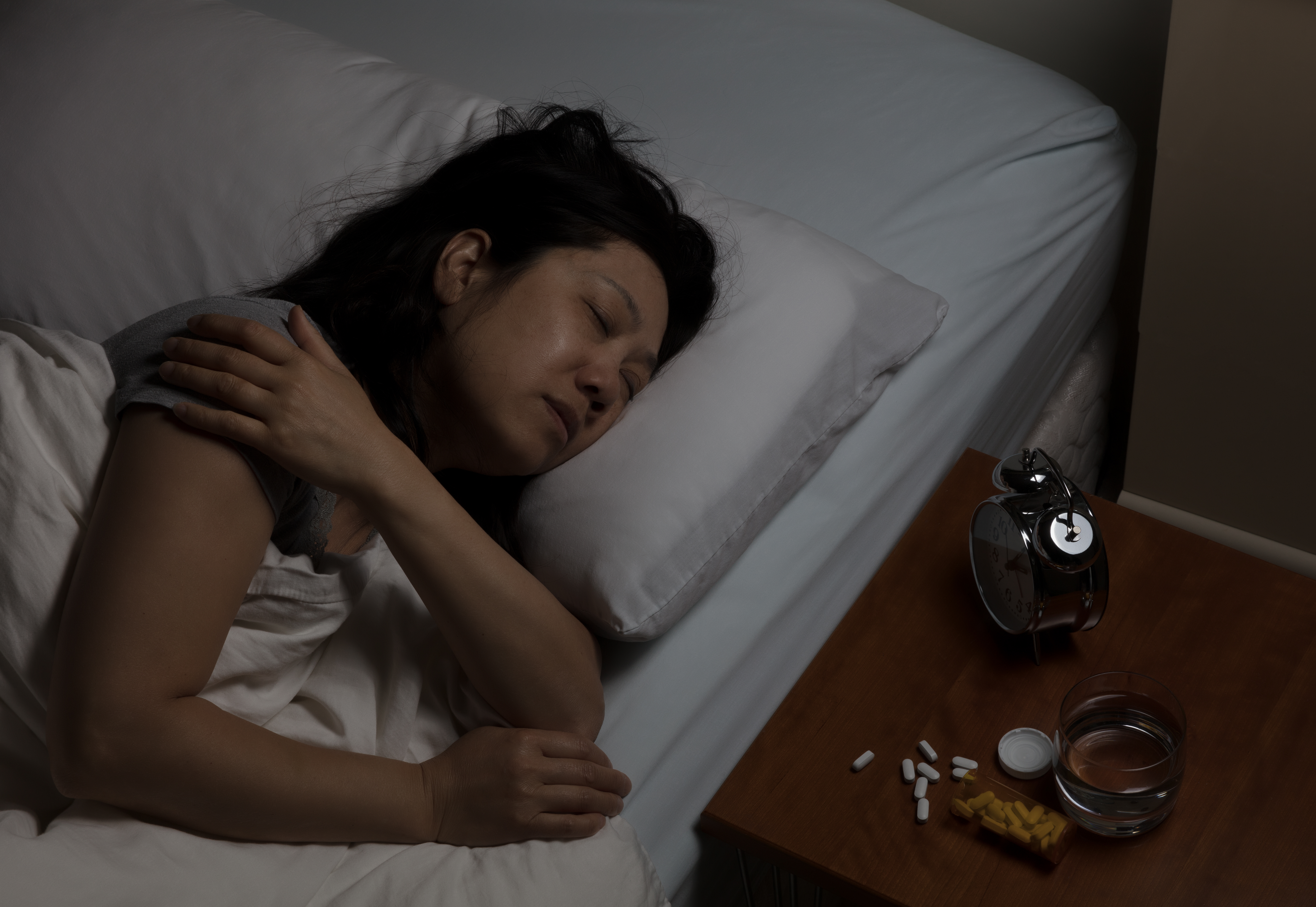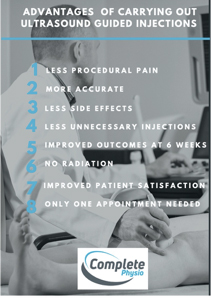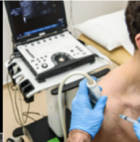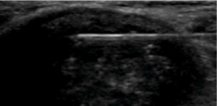Injection therapy for shoulder pain
Overview
Injections have been carried out for over 30 years for musculoskeletal pain, and the shoulder is no exception. The scientific and medical literature support the use of injections for shoulder pain and in the right cases is a very effective treatment modality.
Shoulder injections are therapeutic, as well as diagnostic. If the injection works well and you gain significant pain relief then it is an indication that the pain is arising from the structure injected. Whereas if it does not improve then it indicates that the structure injected is unlikely to be the pain causing structure. This will avoid unnecessary repeat injections and will help to formulate a working diagnosis.
A vast majority of shoulder injections are steroid injections (also known as corticosteroid injections), but we also inject hyaluronic acid and Platelet Rich Plasma (PRP).
Type of Injection:
1/ Steroid Injections
Steroid is a strong anti-inflammatory medication that can provide rapid pain relief and restoration of movement. Steroid injections are very effective at relieving night pain in conditions such as frozen shoulder, sub-acromial bursitis and tendon complaints. They are often used to provide a ‘window of opportunity’ to allow you to engage in a comprehensive physiotherapy programme. More information regards steroid injections can be found on the NHS website.
2/ Hyaluronic acid injections
Hyaluronic Acid injections such as Ostenil Plus also have anti-inflammatory benefits while additionally stimulating synovial fluid production which has a lubricating affect. Hyaluronic Acid injections have a role in chronic degenerative joint disease such as osteoarthritis of the glenohumeral (shoulder) joint and acromio-clavicular joint.
3/Platelet Rich Plasma (PRP)
Platelet Rich Plasma (PRP) injections involve taking the clients blood, spinning it in a centrifuge and separating the blood. The PRP is then injected into the joint. This can be used for rotator cuff tears and shoulder osteoarthritis. This is a relatively new technique but has had some promising results in the literature.
Conditions that respond to injection therapy
The conditions that respond very well to injection therapy are:
- Frozen shoulder – inflammation of the joint capsule. Hallmark signs are severe pain and a gradual reduction of shoulder movements both active and passive.
- Rotator cuff pain – this can include tendon tears and tendinopathy. They cause pain and weakness with active movements resulting in a secondary condition called shoulder impingement.
- Sub-acromial bursitis – The bursa of the shoulder is a very pain sensitive structure when it becomes inflamed (known as a ‘bursitis’). It often causes severe pain at night.
- Calcific tendinitis/tendinopathy – Calcifications are small calcific (bony deposits) within the rotator cuff tendon. These can cause very acute, sudden pain, often with no apparent reason.
- Long head of biceps tenosynovitis – Inflammation of the tendon at the front of the shoulder can cause pain particularly with overhead movements.
- Acromio-clavicular joint (ACJ) sprain and osteoarthritis – ACJ pain occurs at the joint between the collar bone (clavicle) and the shoulder blade (acromium). ACJ sprains can occur due to fall or trauma. Painful ACJ osteoarthritis has a gradual onset of pain.
- Shoulder osteoarthritis – is progressive joint degeneration of the “ball and socket” of the shoulder. The cartilage (a thin protective surface on the ends of the joint) becomes thinner and less smooth. This results in pain and stiffness of the joint.
Many of these shoulder conditions can present quite similarly. The following symptoms are not uncommon for a variety of these conditions.
1/ Pain located around the upper aspect of the shoulder
2/ Pain with movement such as bringing the hand above your head and behind your back
3/ Pain with any activities such as putting on a coat or carrying or lifting a weight
4/ Pain with overhead sports such as weight lifting, tennis and squash.
5/ Pain at night that wakes you up

Due to the overlap in symptoms between these shoulder conditions it can be very difficult for patients to self-diagnose their conditions. It is essential that you get a diagnosis as soon as possible. A diagnostic ultrasound scan is required to diagnose a majority of these shoulder conditions and rule out other causes of your pain.
An accurate diagnosis can prevent many weeks and months of unnecessary pain. A painful stage 1 frozen shoulder and an acute calcific tendinopathy that wakes you at night, does not respond well to physiotherapy and it can even aggravate the pain. Frozen shoulder and calcific tendinopathy are two conditions that often require a steroid injection and we would advise where appropriate that this is considered as soon as possible.
How effective are shoulder injections?
Frozen shoulder
The National Institute of Clinical Excellence (NICE) provides national guidance and advice to improve health and social care. It provides evidence based recommendations to guide best practice within the NHS. The NICE guidelines for frozen shoulder recommend ‘an intra-articular (glenohumeral) corticosteroid injection early in the course of frozen shoulder if there is no, or slow, progress with conservative treatment’.
A single intra-articular steroid injection has shown a significant improvement in pain, an ability to move your arm along with being easier to carry out daily tasks such as dressing/undressing (Rangan 2015 & 2016, Maund, 2012). Undertaking physiotherapy after a steroid injection has also been shown to be more effective than physiotherapy alone (Rangan, 2016). Steroid injections are most effective in the painful stage (stage 1) of a frozen shoulder . They are less effective in the stiff phase (stage 2). A hydrodilatation injection is more appropriate during the stiff phase of a frozen shoulder.
The most recent systematic Cochrane review by Buchbiner et al, 2003 of randomised controlled and pseudo-randomised trials supports the use of steroid injections in the treatment of frozen shoulder.
A more recent systematic review by Griesser et al, 2011, analysed all randomised controlled trials (RCT’s) and concluded that intra-articular steroid injections for frozen shoulder resulted in significant pain relief, along with improvements in pain and function.
Rotator cuff pain – tendinopathy or tear
NICE recommend that subacromial corticosteroid injections can be used in the management of subacromial shoulder pain (Royal College of Surgeons, 2014, Kulkarni, R, 2015). They recommend injections should be used alongside physiotherapy management (Hazelman, 2005).
It has also been recommended for those with severe pain and significant limitations in shoulder range and function that a steroid injection should be considered before embarking on a course of physiotherapy. It is acknowledged that in some cases that physiotherapy can aggravate the symptoms, so an injection prior to physiotherapy can improve your tolerance to rehabilitation (Burbank et al, 2008).

Guidelines recommend steroid injections for patients with :
- severe pain (Diercks et al, 2014)
- persistent pain or those making little progress with rehabilitation (University of New South Wales, 2013).
- significantly reduced function due to pain (Burbank et al, 2008).
It is important to limit the number of steroid injections for rotator cuff pain. The British Elbow & Shoulder Society (BESS) and the Royal College of Surgeons recommend not to give more than two steroid injections (Royal College of Surgeons, 2014, Kulkarni, 2015). Evidence suggests that frequent injections could cause damage to tendons (Dean, 2014).
UK guidelines recommend that subacromial corticosteroid injection can be used in the management of subacromial bursitis (Royal College of Surgeons, 2014, Kulkarni, 2015). NHS guidelines recommend a steroid injection for bursitis to reduce pain and improve function. Steroid injections for sub-acromial bursitis should be combined with a comprehensive physiotherapy programme.
In a recent literature review with 376 patients, ultrasound guided sub-acromial (also known as sub-deltoid) bursa steroid injections resulted in significant improvement in pain and disability scores in two-thirds of patients. There was no difference in pain reduction in those patients who did and those who did not have a rotator cuff tear. This indicates that having a rotator cuff tear is not a predictor of a poorer outcome from a steroid injection (Fawcett et al, 2018).
Calcific tendinitis/tendinopathy
A well established advanced injection technique for calcific tendinopathy is called a ‘barbotage and lavage’ procedure. This procedure uses local anaesthetic to break down and ‘suck out’ the small bony deposits in the tendon (‘calcifications’) using a needle.
The barbotage and lavage procedure is more effective than steroid injection alone and results demonstrate over a 70% improvement in pain. The positive effect of the barbotage and lavage procedure remained at the one year follow up (Bas de Witte et al, 2013). In one study involving 908 patients, this technique has been shown to have a high success rate in all recorded outcomes and low complication rates. Patients reported a significant improvement in pain, range of movement and function (Gatt et al, 2014).
This technique has very promising studies supporting its use and often negates the need for surgery to remove the calcification from the tendon. It however requires a significant amount of skill and experience to perform.
Long head of biceps tenosynovitis – is a less common cause for shoulder pain and is often over diagnosed. However, it has been shown to often occur alongside other shoulder pathologies such as rotator cuff disorders (Redondo-Alonso et al, 2014). The long head of biceps tendon is sometimes referred to as the ‘fifth’ rotator cuff. It is involved in shoulder impingement disorders and can be a target for a steroid injection, particularly when a sub-acromial bursa injection has not provided significant enough pain relief.
Non-operative treatments including steroid injections with local anaesthetic are advocated for the treatment of biceps tendon issues (Zhang et al, 2011). In this study, 80% of patients had significant pain relief following an injection into the sheath of the biceps tendon using ultrasound guidance. The ultrasound guided group had a significantly improved outcome when compared to ‘unguided’ or landmark guided injections.
Morrison et al, 1997, also showed that a steroid injection into the sheath of the biceps showed a significant reduction in pain and an improvement in function on a 100 point scale.
Acromio-clavicular joint injections
Ultrasound guided steroid injections for acromioclavicular joint pain, whether this is due to osteoarthritis or a joint sprain, is a well-established treatment option. It should be reserved for those not improving with physiotherapy or those where the pain is affecting their ability to engage in a course of physiotherapy.
Sabeti- Aschraf et al (2011 & 2013) conducted a randomised study and showed that patients had significant improvement in pain and function after one month following a steroid injection. A randomised trial showed significant benefit of a steroid injection in favour of physiotherapy and manipulation (Buchbinder et al, 2003). We believe it is essential that an injection is part of an overall management programme which includes physiotherapy.
There is minimal evidence for hyaluronic acid injections in acromioclavicular joint osteoarthritis. It has been extensively studied in other osteoarthritic joints and has shown favourable results. A Cochrane review demonstrated a reduction in pain and a significant improvement in pain and function (Bellamy et al, 2006). In these studies, hyaluronic acid also had a longer lasting effect than steroid injections in osteoarthritic joints. These studies indicate a role for hyaluronic acid injections in osteoarthritic acromioclavicular joints .

Shoulder (glenohumeral joint) osteoarthritis
Corticosteroid injections are supported by the current NICE guidelines as a treatment option for shoulder osteoarthritis. NICE suggest a shoulder injection should be considered for short-term pain relief during an exacerbation of pain or a ‘flare-up’. The British Elbow & Shoulder Society (BESS)/British Orthopaedic Association (BOA) guidelines also suggest the use of steroid injections for the short term management of pain (Thomas, 2016).
BESS and BOA also advise the use of hyaluronic acid (HA) injections, as an alternative to steroid injections, for those cases not improving and/or with inadequate pain control.
HA injections are widely used for painful osteoarthritis in a variety of joints. Glenohumeral (shoulder) injections have been used for over a decade and a recent systematic review by Zhang et al (2019) demonstrated that patients improved in both pain and function following a HA injection into the shoulder joint. They reported very few side effects. It was also acknowledged in this study, that the control group also improved, so the authors conclude the effect may be due to the placebo effect of the injection.
A novel injection technique is Platelet Rich Plasma (PRP). There is a limited amount of research into this area, but initial reports show some promising results. One study showed that PRP injections was effective and better than steroid injection in the treatment of OA shoulder (Kothari & Srikumar, 2017).
Should injections be carried out with ultrasound guidance?
At Complete all injections are carried out with ultrasound guidance to ensure maximal pain relief with minimal procedural pain. A comprehensive systematic review concluded that shoulder injections should be carried out with ultrasound guidance to achieve the best results and limit the number of side effects (Soh et al, 2011).
There are many advantages to using ultrasound guidance to guide the injection (see image below).

We will now look at the accuracy of guided versus unguided injections around the shoulder in more detail;
Shoulder (glenohumeral) joint injections:
There is a significant body of evidence to suggest that all injections into the shoulder joint (‘ball and socket’ joint) should be guided i.e. using ultrasound or fluoroscopy (X-ray). Shoulder joint injections are carried out for frozen shoulder and osteoarthritis.
A study by Eustace et al (1997) reported an accuracy rate of 42% (10 of 24) for unguided glenohumeral joint injections i.e. 6 of 10 unguided injections miss the target and do not go into the joint. The injections that did successfully go into joint showed improved pain relief.
Finnoff et al (2015) reported 100% accuracy rate of ultrasound guided injections in the joint. It was concluded to get the best results and to achieve rapid pain relief all shoulder joint injections should be carried out with guidance.
Bursa injections
Injections that are isolated to the bursa using ultrasound guidance resulted in more significant pain relief and less pain during and after the procedure. The studies show that the accuracy of ultrasound guided injections is 100% accurate, whereas unguided injections accuracy ranges from 30-76% (Henkus et al, 2006; Eustace et al, 1997). This implies that 3 to 7 injections out of every 10 do not hit the intended target if they are not guided.
Long head of biceps injections
A well conducted study by Hashiuchi et al (2011), assessed the accuracy of injections into the sheath of long head of biceps. They concluded that without ultrasound guidance there is only a 27% chance the steroid will be injected into the correct location, whereas ultrasound guided injections were 87% accurate. This has been repeated in other studies.
Acromioclavicular (AC) joint injections
Despite this being a superficial injection, the studies show that it should always be carried out with ultrasound guidance. It has been demonstrated that without ultrasound guidance only 30% of all injections go into the joint. Guided injections deliver the medication in 95-100% of injections and have improved outcomes.


All of our injections are carried out using ultrasound guidance so we can guide the needle and deposit the medication in the target structure. Often the target structure such as the bursa, tendon or the joint are only a few millimetres in size, so it is essential the injection is carried out using ultrasound guidance. The more experience and training the clinicians have the more accurate and effective the injections can be.
When should you consider an injection for shoulder pain?
You should only consider a steroid injection when you have a clear diagnosis and your:
1/ pain that is not improving
2/ pain which is significantly affecting your daily activities
3/ pain that wakes you up at night and is affecting your quality and amount of sleep
Injections should always be combined with a course of physiotherapy
All shoulder injections are utilised in conjunction with rehabilitation under the guidance of a physiotherapist to restore full range of movement in the joint and muscle strength. Examples where physiotherapy is crucial following an injection to ensure a positive outcome are rotator cuff pain (tears and tendinopathy) and a sub-acromial bursitis.
If you have any questions about this article then please do not hesitate to contact our clinical director at chrismyers@complete-physio.co.uk
References:
Aly, A. R., Rajasekaran, S., & Ashworth, N. (2015). Ultrasound-guided shoulder girdle injections are more accurate and more effective than landmark-guided injections: a systematic review and meta-analysis. Br J Sports Med, 49(16), 1042-1049.
Bellamy, N., Campbell, J., Welch, V., Gee, T.L., Bourne, R. and Wells, G.A., 2006. Viscosupplementation for the treatment of osteoarthritis of the knee. Cochrane database of systematic reviews, (2).
Buchbinder,R., Green,S. and Youd,J.M. (2003) Corticosteroid injections for shoulder pain (Cochrane Review). The Cochrane Library. John Wiley & Sons, Ltd.
Burbank,K.M., Stevenson,J.H., Czarnecki,G.R. and Dorfman,J. (2008) Chronic shoulder pain: part II. Treatment. American Family Physician. 77(4), 493-497.
de Witte, P.B., Selten, J.W., Navas, A., Nagels, J., Visser, C.P., Nelissen, R.G. and Reijnierse, M., 2013. Calcific tendinitis of the rotator cuff: a randomized controlled trial of ultrasound-guided needling and lavage versus subacromial corticosteroids. The American journal of sports medicine, 41(7), pp.1665-1673.
Dean, B.J. and Franklin, S.L, Murphy R.J, et al (2014) Glucocorticoids induce a specific ion-channel mediated toxicity in tendon. British Journal of Sports Medicine. 48(22), 1620-1626.
Diercks, R., Bron, C. and Dorrestijin, O. et al (2014) Guideline for diagnosis and treatment of subacromial pain syndrome: a multidisciplinary review by the Dutch Orthopaedic Association. Acta Orthopaedica. 85(3), 314-322
Eustace, J. A., Brophy, D. P., Gibney, R. P., Bresnihan, B., & FitzGerald, O. (1997). Comparison of the accuracy of steroid placement with clinical outcome in patients with shoulder symptoms. Annals of the Rheumatic Diseases, 56(1), 59-63.
Fawcett, R., Grainger, A., Robinson, P., Jafari, M. and Rowbotham, E., (2018). Ultrasound-guided subacromial–subdeltoid bursa corticosteroid injections: a study of short-and long-term outcomes. Clinical radiology, 73(8), pp.760-e7.
Finnoff, J. T., Hall, M. M., Adams, E., Berkoff, D., Concoff, A. L., Dexter, W., & Smith, J. (2015). American Medical Society for Sports Medicine position statement: interventional musculoskeletal ultrasound in sports medicine. Clinical Journal of Sport Medicine, 25(1), 6-22.
Gatt, D.L. and Charalambous, C.P., 2014. Ultrasound-guided barbotage for calcific tendonitis of the shoulder: a systematic review including 908 patients. Arthroscopy: The Journal of Arthroscopic & Related Surgery, 30(9), pp.1166-1172.
Hashiuchi, T., Sakurai, G., Morimoto, M., Komei, T., Takakura, Y., & Tanaka, Y. (2011). Accuracy of the biceps tendon sheath injection: ultrasound-guided or unguided injection? A randomized controlled trial. Journal of shoulder and elbow surgery, 20(7), 1069-1073.
Hazleman,B. (2005) Shoulder problems in general practice. Reports on the Rheumatic Diseases Series 4. Arthritis Research Campaign.
Henkus, H. E., Cobben, L. P., Coerkamp, E. G., Nelissen, R. G., & van Arkel, E. R. (2006). The accuracy of subacromial injections: a prospective randomized magnetic resonance imaging study. Arthroscopy: The Journal of Arthroscopic & Related Surgery, 22(3), 277-282.
Kothari, S.Y. and Venkataraman Srikumar, N.S., 2017. Comparative efficacy of platelet rich plasma injection, corticosteroid injection and ultrasonic therapy in the treatment of periarthritis shoulder. Journal of clinical and diagnostic research: JCDR, 11(5), p.RC15.
Kulkarni, R., Gibson, J. and Brownson, P. et al. (2015) BESS/BOA patient care pathways: subacromial shoulder pain . Shoulder & elbow. 7(2), 143.
Maund, E., Suekarran, S. and Neilson, A. et al (2012) Management of frozen shoulder: a systematic review and cost-effectiveness analysis. Health Technology Assessment. 16(11), 1-264
Morrison, D.S., Frogameni, A.D. and Woodworth, P., (1997). Non-operative treatment of subacromial impingement syndrome. JBJS, 79(5), pp.732-37.
Rangan, A., Hanchard, N. and McDaid, C. (2016) What is the most effective treatment for frozen shoulder?. British Medical Journal. 354(Aug 23), i4162. [Abstract]
Rangan, A., Goodchild, L. and Gibson, J. et al (2015) BESS/BOA patient care pathways: frozen shoulder . Shoulder & elbow. 7(4), 299-307.
Redondo-Alonso, L., Chamorro-Moriana, G., Jiménez-Rejano, J.J., López-Tarrida, P. and Ridao-Fernández, C., (2014). Relationship between chronic pathologies of the supraspinatus tendon and the long head of the biceps tendon: systematic review. BMC musculoskeletal disorders, 15(1), p.377.
Sabeti-Aschraf, M., Lemmerhofer, B., Lang, S., Schmidt, M., Funovics, P.T., Ziai, P., Frenzel, S., Kolb, A., Graf, A. and Schueller-Weidekamm, C., 2011. Ultrasound guidance improves the accuracy of the acromioclavicular joint infiltration: a prospective randomized study. Knee Surgery, Sports Traumatology, Arthroscopy, 19(2), pp.292-295.
Sabeti-Aschraf, M., Stotter, C., Thaler, C., Kristen, K., Schmidt, M., Krifter, R.M., Hexel, M., Ostermann, R., Hofstaedter, T., Graf, A. and Windhager, R., 2013. Intra-articular versus periarticular acromioclavicular joint injection: a multicenter, prospective, randomized, controlled trial. Arthroscopy: The Journal of Arthroscopic & Related Surgery, 29(12), pp.1903-1910.
Soh, E., Li, W., Ong, K. O., Chen, W., & Bautista, D. (2011). Image-guided versus blind corticosteroid injections in adults with shoulder pain: a systematic review. BMC musculoskeletal disorders, 12(1), 137.
Thomas, M., Bidwi, A. and Rangan, A. et al (2016) BESS/BOA patient care pathways: glenohumeral osteoarthritis. Shoulder & elbow. 8(3), 203-214
Univerity of New South Wales (2013) Clinical practice guidelines: management of rotator cuff syndrome in the workplace. Univerity of New South Wales.
Zhang, J., Ebraheim, N. and Lause, G.E., (2011). Ultrasound-guided injection for the biceps brachii tendinitis: results and experience. Ultrasound in medicine & biology, 37(5), pp.729-733.
Zhang, B., Thayaparan, A., Horner, N., Bedi, A., Alolabi, B. and Khan, M., 2019. Outcomes of hyaluronic acid injections for glenohumeral osteoarthritis: a systematic review and meta-analysis. Journal of shoulder and elbow surgery, 28(3), pp.596-606.

